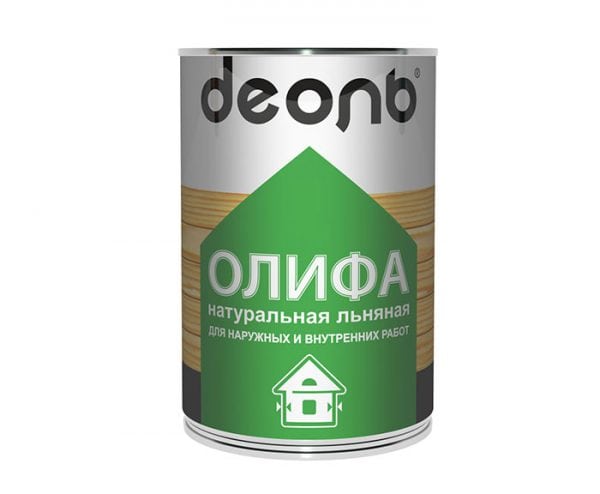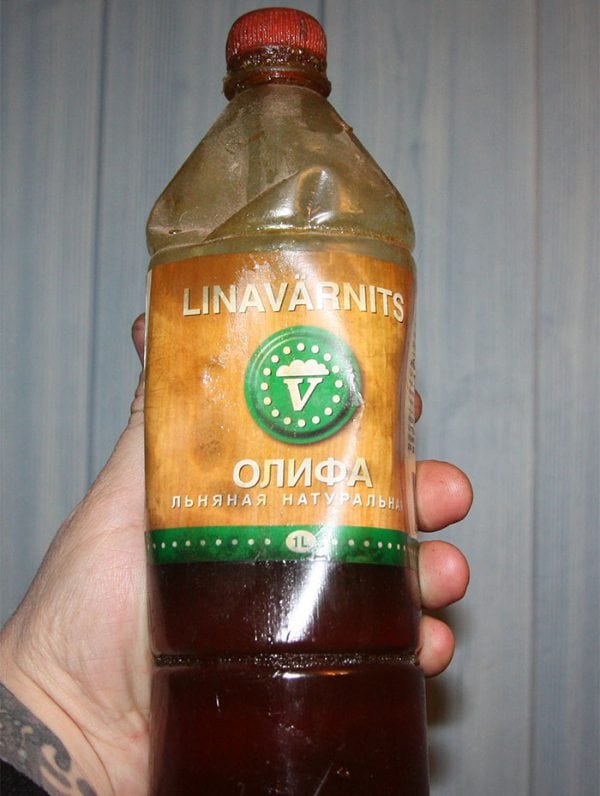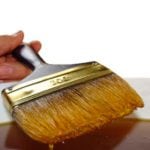Drying oil is a protective composition that forms a film on the treated surface. It consists of various vegetable oils, sometimes tinting substances, minerals, additives that increase surface strength. As a rule, a combined composition is produced by boiling, oxidizing, heating to certain temperatures, as a result of which all components dissolve and create a viscous, oily liquid.

Type of drying oil
If your drying oil is a little thickened, you should accurately understand its appearance in order to properly breed it. It may contain various materials that have a natural or synthetic composition:
- Natural - based on vegetable oil, with the addition of natural components (resins, esters, wax). As a rule, it has a great price, because it does not vaporize into the room toxic and harmful substances to the body.
- Semi-natural - synthetic components are added to the composition, enhancing the wear resistance of the film, increasing the penetrating ability of the compositions, and surface smoothness.
- Combined - based on vegetable oils, compounds are created to prepare the painted surface. It is diluted with synthetic materials, which are used for the cultivation of acrylic paints, varnishes, primers, glaze coatings.
- Synthetic - a completely artificial material that can paint wood, applied to walls, other coatings.
Natural drying oils
They are found most often, because with their safety and environmental friendliness they have a fairly favorable cost. Since they are based on sunflower, linseed tung or other oils, they can act as a solvent. The need to dilute such a tool is rare, since the oil has been in a liquid state for a long time, does not evaporate moisture, does not need regular replenishment of the solvent. As a rule, natural drying oil has a transparent or light shade.
It should be noted that the drying (absorption) time is about a day. Even applied to metal structures, drying oil is very effective, because it penetrates into the pores, is polarized and reduces the consumption of the finishing coat at times.

Typical places for use are floor boards, wood panels, structures, logs, and a rafter system. In order to reduce costs, natural drying oil can be diluted with ordinary vegetable oil. This will help when processing a large area where compliance with the technology of work is not required. For example, when processing the floor in the attic, in the basement, processing slopes and roof battens.
to contents ↑Home dilution
First of all, it is worth remembering that drying oil belongs to fire hazardous materials, under certain conditions it can even provoke an explosion.
Therefore, it must be diluted under controlled conditions:
- in rooms with good ventilation;
- far from sources of fire;
- proven compounds.
If you are working with material whose composition is not known to you, it is worth diluting it only with gloves, as it can cause chemical burns if it gets on your skin.After you have worked on the cultivation of drying oil, you must tightly close it with a lid, remove from direct sunlight, and prevent excessive heating of the tank.
Suitable for dilution:
- White spirit solvent;
- Castor oil;
- Any other factory paint thinner.
At the same time, it is recommended to add only 1 part of the solvent to 10 parts of drying oils, no more, since the physicochemical properties are lost.
Many home masters try to “reanimate” drying oil, which has been in a closed container for more than a year. Even if it remains liquid, transparent, a precipitate has not precipitated - the composition is not suitable for use, and can cause more harm to the builder than good.

When diluting synthetic drying oil, it is necessary to follow all the manufacturer's recommendations, since the solvent can completely ruin it.
When breeding drying oil, which has the properties of hardening, one should not count on the full restoration of its properties, one of which is the integumentary ability. If you are confident in the quality of the protective material and observe precipitation, film formation, you can simply strain the drying oil through a metal strainer. This will prevent small particles of sludge from getting onto the surface to be treated and ensure its smoothness.
Skeptics argue that the process of dilution of drying oil is completely meaningless, since the polymerization process has already passed. Of course, the original properties and qualities of drying oil will not be restored, but due to increased fluidity, improved viscosity, penetrating ability, drying oil can be used in those areas where high quality processing is not required.
Turpentine, synthetic paints for paints can also be used as a solvent. Sometimes it helps to add drying oils of the same type to a container with a stiffened one. It is important to monitor the reaction of the hardened material so that precipitation does not precipitate sharply due to exposure to aggressive chemicals. It is best to add solvent liquid gradually.
to contents ↑Breeding errors
It is not recommended to use gasoline, kerosene or diesel fuel as a solvent. Drying oil can be divorced, but fire hazard increases dramatically. In addition, in residential areas, the application of such a composition is prohibited.
Immediately after completing work, wash the entire instrument with soap or other detergent. Otherwise, it will end with polymerization (solidification) of the material, and damage to the tool.





